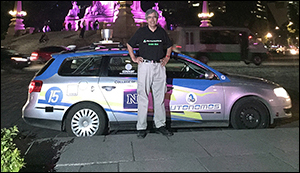Autonomous car finishes record-setting trip in Mexico
2. 11. 2015 | University of Nevada, Reno | www.unr.edu
Professor Raul Rojas of the University of Nevada, Reno just drove 1,500 miles without hands - from the U.S. border at Nogales to Mexico City - in his autonomous car. It is the longest-ever autonomous drive in Mexico.
With several terabytes of data describing the highways, and with specialized software, the onboard computer guided the car on city streets and highways through the Sonoran Desert, along the west coast of Mexico, up to Guadalajara and then to its final destination of the National Polytechnic University, Instituto Politecnico Nacional, in Mexico City.

This trip along Mexico's Highway 15 sets, by far, a new personal best for Rojas, as his autonomous car, a 2010 Volkswagen Passat Variant, had already driven 190 miles round trip between Berlin and Leipzig, Germany. The car is equipped with a highly precise GPS system and specialized equipment that allows it to follow a pre-set route, and then drive on its own with other systems controlling speed, direction and braking. A roof antenna receives GPS satellite signals from which a computer calculates the position of the car on the earth's surface.
Read more at University of Nevada, Reno
Image Credit: University of Nevada, Reno
-jk-




